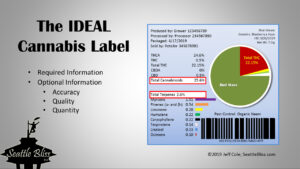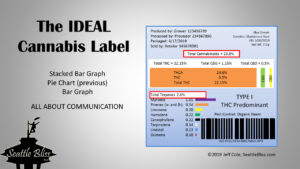The label is the Producer/Processor’s owned advertising space. Reviewers scrutinize and Consumers recognize! Higher Ground Contributors might even show a copy of it in their review. You want to look your best, don’t you growers? You paid the lab for all of that information, why not disclose it all on the label? The front side is usually reserved for recognition elements, such as branding, while most other sides are left unused with the exception of a tiny bit of required information (usually printed on the lowest-quality paper), the secondary label.

The Ideal Secondary Cannabis Label lists every cannabinoid present in quantity itemized in its acid form, neutral form, and the total with formula. States each have their own requirements, but this means that if one has a THC-dominant strain that also has a quantifiable CBG presence, then ‘ideally’ each should be given in all three quantities – THC, THCA, Total THC, CBG, CBGA, Total CBG. CBN should be listed if present in measurable quantity.
The state of Washington, Higher Ground’s guide in this process, has simplified labeling requirements as of 2020. Total THC and Total CBD are the only cannabinoid quantities required now. (See the Seattle Bliss article: https://www.seattlebliss.com/2019/12/washington-cannabis-labels-just-got-bit.html)
Show quantities with charts and graphs if possible. The pie chart is a good way to represent the THC to CBD ratio, and if there’s a CBG or CBC to add in there, great.

A bar graph has become the standard for representing the terpene profile. A truly great grower will present the top five or six terpenes in a full color bar graph. Any claims such as “5% terpenes” need to be backed up by listing the individual quantities of your top five or six terpenes along with the total.

For consumers, if it looks like there’s a big gaping hole, it’s probably CBN. That’s the thing the consumer needs to remember in this instance. If THC is unclear, yet the label brags about total cannabinoids, it’s probably CBN you’re smoking. Enjoy your nap.
For the growers out there, be honest. Presenting total cannabinoids should require showing your math. List your quantities as they actually appear on the lab test results. Your customer wants to understand the quality of the whole flower they are purchasing. Deliver!
If your “Agent Orange” only tests at 14% THCA say so! If you’re listing that, you’d do well to list THC and Total THC. Other cannabinoids, CBG and CBC for example, may be itemized in summary with Total Cannabinoids. Sometimes this is actually a bonus.
One of these days Congress will reclassify cannabis and open all the doors that have been closed to clinical research. Perhaps, then we’ll have a better understanding of cannabis and all of the cannabinoids, but until then we’re going to have to rely on Professionals – that’s Producers and Processors – getting their labels right, and the rest of us learning what we need to know. We can do this, everyone!
For HigherGround420.com Contributor Reviews, enter data exactly as it appears on the label. If a label lists only three cannabinoids, THC, CBD and Total, enter THC and CBD in their appropriate fields. Just remember that Total, in this case, must be assumed to be Total Cannabinoids. Please enter Total in the Total Cannabinoids field.
For Reviewers in early implementation states (congratulations Michigan), please complete as many data fields as possible. NEVER SUBMIT A REVIEW FOR A PRODUCT WITHOUT DOCUMENTATION OF THE GROWER (PRODUCER), THE BRAND or WHOLESALER (PROCESSOR), AND THE LEGAL PURCHASE FROM A LICENSED DISPENSARY OR RETAILER. Oklahoma MMJ Growers are currently able to dispense several ways – know the grower, wholesaler or brand, and the seller are legitimate before submitting a review. Please upload photos of all those labels and help us compile a collection for everyone to share.


